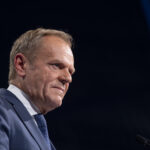Romania’s super-electoral year started on Sunday with European Parliament and local elections. The country awaits its presidential and national parliamentary elections in the autumn.
Two things appeared confirmed as this election round ended. Firstly, Romania is not vulnerable to Russian propaganda and the rise of extremist parties, given an overwhelming majority of 53 per cent for the ruling coalition of Socialists and Democrats (S&D) and European People’s party (EPP) members—the Social Democrats (PSD), and National Liberals (PNL).
Secondly, Romania can present itself as a tranquil island of political stability with the ruling alliance also ensuring a comfortable majority in local elections. Both conclusions would strengthen Romania’s position in the region, as a provider of security to neighbouring countries, and in negotiations for key portfolios in the EU.
Nevertheless, Romania’s external strength is threatened by an increasingly clear leadership gap. Leading political parties in Romania have exceptional organisational capacity but are not able to nominate suitable candidates.
Why no rise of extremist parties in Romania?
Romanian society showed its resilience to Russian propaganda and disinformation, given the lower-than-expected scores of the far-right parties AUR and SOS (although both made the threshold that will see them take seats in Brussels and Strasbourg).
The Romanian public is not keen to support anti-European parties due to its highly favourable perception of the European Union, and the strategic partnership with the US and NATO. The historical threat of Russia has led to a rejection of the Kremlin’s propaganda in general. A great deal of credit for this societal resilience is due to the ample and sophisticated public awareness and countering disinformation campaigns led by media and civic actors.
In contrast, the resilience of mainstream parties is derived from their organisational and mobilisation expertise. The cartelisation of the political parties in Romania has for decades prevented the rise of fringe or extreme right parties, to the level found in other EU member states.
Given its stability in power and lack of opposition, this ruling coalition has exerted control over public resources. It has engaged in a series of budgetary expenses that have led to a doubling of its public deficit, to both a historical level and the second highest in the EU. This allowed ruling political actors to maintain control over their local organisations, through budgetary clientelism. As this electoral mobilisation strategy is costly, and the budgetary space is shrinking, it is unclear the extent to which it will hold in time.
Why no more political instability?
There has been a very close cooperation between the leaders of the major ruling political parties in Romania—Marcel Ciolacu (PSD) and Nicolae Ciucă (PNL). They have alternated in office as prime ministers and have tried their best to pursue an alliance platform for the elections this year, with a single candidate for city halls, and a single candidate for presidential office.
Their goal was political stability for the country and their platforms. This strategy has failed, given large incompatibilities ranging from the political organisations to the electorate and policy preferences (such as fiscal policy). Running on joint lists for the European Parliament and county councils, they together gained comfortable majorities. With separate candidates for city halls, they lost major cities, such as Bucharest or Timișoara, in favour of candidates from much smaller parties, alliances or even independents. Over half of the voting population in Romania now favours independent candidates.
The political scores of the two governing parties are relatively close, as the Social Democrats have a total score of 35 per cent and National Liberals of 28 per cent. As such, both party leaders have now announced that they have presidential aspirations, strongly pushed forward by their political apparatus.
As the president in Romania directly controls the appointment of secret service leaders, he (or she) exerts an enormous amount of informal power outside the formal lines of a semi-presidential republic. That is why it is unimaginable that the incumbent government can survive in its current form without a presidential ally. However, should both members of the coalition field a candidate its survival must be brought into question.
The outgoing president, Klaus Iohannis, has been the architect of the current governing coalition, but after his two terms in office, he is trying to leverage an unrealistic bid for NATO secretary general for an important role in the EU. He is probably looking towards the new Defence Commissioner portfolio if it does not land with the Polish Foreign Affairs Minister Radosław Sikorski.
Finally, the results of local elections this Sunday in Romania have shown once more, the internal divides between the metropolitan area of Bucharest, and the rest of the country. Political preferences not only show divides between urban and rural populations but also between segments that are at the very extreme ends of the welfare and income spectrum.
With the rich getting richer and the poor poorer, Romania demonstrates an impoverished majority susceptible to old-school political mobilisation, and a reactive, civically minded urban public, heavily concerned with checks and balances and the quality of governance. Thus, social and political polarisation is growing in this country too.
Romania’s (geo)political ambitions
The Romanian public, more even than its politicians, is hungry for geopolitical relevance. There is an acute sense of threat, but also of solidarity with neighbouring countries, since the start of the war in Ukraine.
This feeling of historical opportunity comes in contrast to historical frustrations of East-West divides in the EU, with the feeling of being treated as second-class citizens amongst the almost six million Romanians living in the West, and with the sense of being overlooked in key appointments in the EU.
The Romanian public is keen to embrace its role in the European Union and the Eastern Enlargement, in a context in which more and more of the Western public is reluctant towards both, given the rise of extremist parties in France, Netherlands or Germany.
Romania’s external aspirations will have to come with a cleaning of the house internally, and a much clearer vision by political elites for the future of the country they want to run. Its internal affairs need to be the foundation of its external projection of power. If the new European Commission will still have to be geopolitical in its approach, so will Romania’s next president.







